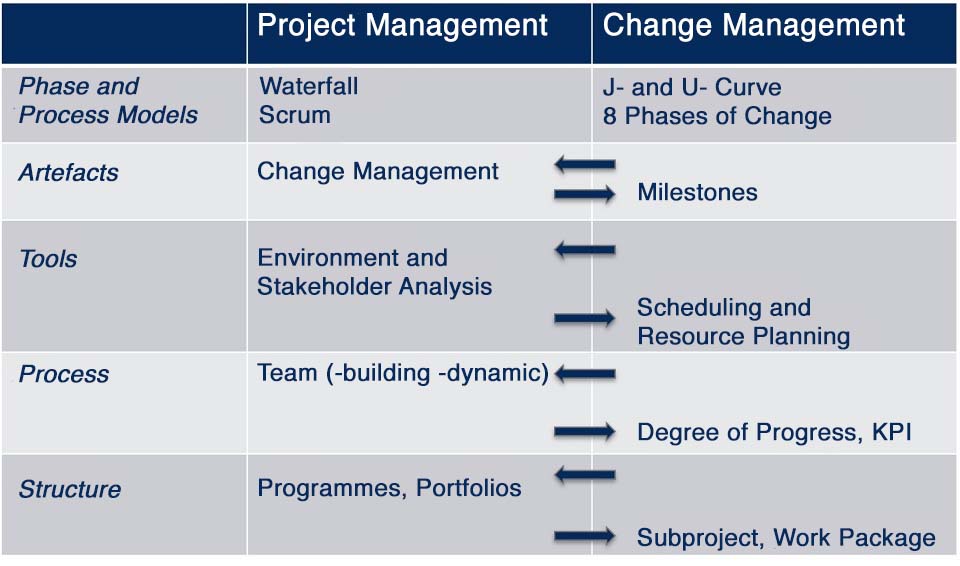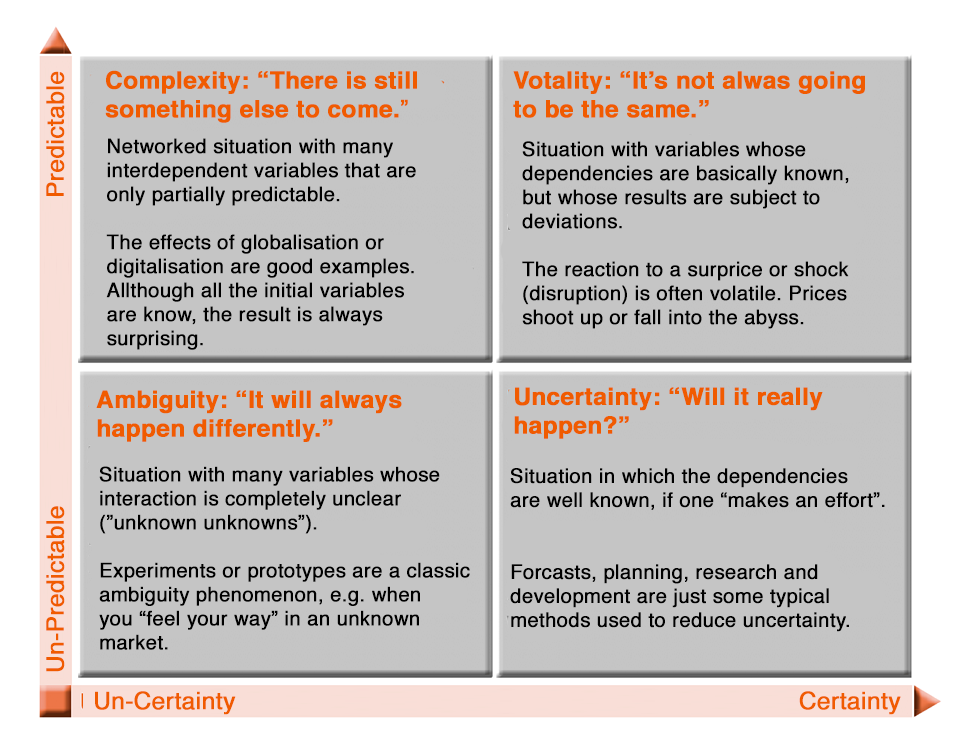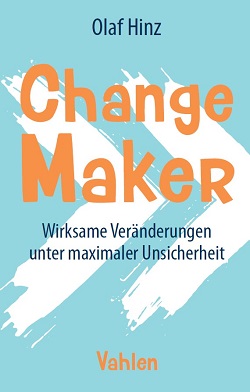Change projects work! – Part 1
What does not work is project theatre! It is time to stop pretending!
- Project managers have learned a lot about changes in the project or about professional environment and stakeholder analysis.
- Change managers have learned how to plan effectively for deadlines and resources, and how to structure projects sensibly.
And yet there is a well-known story: 80% of change projects are supposed to fail. Despite intensive research, I have not been able to empirically verify this figure. Where does this figure come from? Maybe from the Chaos Report of the standish group? But only IT projects are examined there and for years they have always had a success rate of around 30%. Also a sad result!
It remains to be said that the story of the failure of (change) projects is still told and believed. It is a truth that is felt, i.e. the story of failure fits in with our own experience in organisation and change projects.
Change projects and change theatre
Why do we find it so difficult to make these projects a success? Because our project management in the field of change is not dynamicrobust, i.e. it cannot cope with the unplanned, surprises and feedback! Too often the theatre of planned economy still dominates:
- planning,
- structuring,
- problem classification,
- measurement, and much more
as a means of (supposedly) reducing complexity. In addition, standards, methods and tools provide helpful working aids and routines that enable project teams to run standard operations in early phases.
The standard repertoire in change management is far too often still related to a linear, predictable and therefore controllable environment. This has developed into a toolbox that satisfies control fantasies through standardisation, certification and “method fetishism”. That is planned economy change theatre! A plannable process is pretended, which has nothing to do with reality. I am convinced that the phase models that are still taught today in the subject of change management have become ballast because they are too rigid and want to make us believe that organisational projects are predictable.
The business environment is becoming more uncertain, complex and dynamic. This is often described in discussions with the acronyms 4.0, VUCA or Disruption. This new environment leads to the fact that organisations need Change Projects 4.0, which extend the classic repertoire 2.0 of the last twenty years.
Detailed control, procedural models and clear change processes, where every word is at stake in the wording, are already obsolete after their printing. Kanban boards, canvas and sprints, on the other hand, are useful tools for jointly tackling the next steps, making them transparent and making it easier to adapt the procedure to new findings.
7 points for effective change and organisational projects
The following 7 points open up the field for effective change and organisation projects 4.0. Hybrid concepts are needed in which new things are added, existing things are improved and ineffective ballast is thrown off:
- Act quickly and incompletely rather than late and completely.
- Keep the organisational structure in the central value chains stable and at the same time allow for the conflicts and frictions that lead to productive change.
- Design the transformation according to the 3i rule:
+ iterative, i.e. proceeding in steps,
+ integrative, i.e. working with the intelligence of the many in groups, and
+ incremental, i.e. implementing small, functioning “good enough” solutions. - Use structures and subdivision of problems by proven tools as methods of support. However, active management of change must not take a back seat.
- Accept dynamics and uncertainty as normal states and learn not to negate them. In this way you will broaden your view of what is “next”.
- Do not blindly believe in methods, best practices and success factors. Use these necessary tools anyway to give complexity a good home.
- Leading organisational projects means thinking and trying out alternatives instead of putting a lot of effort into finding the right solution.
Anything else would be change theatre, i.e. just the mechanistic execution of theoretical process models.
The parallel existence of change projects
Rigid Management 2.0 will be replaced in future by the robustness of Management 4.0. Change processes are robust if they can expect surprises, react to unplanned events and have adapted their approach and methodology to the increasing dynamics.
In the future we will experience a large number of organisational projects whose architecture will be different. The landscape will become more diverse. It will rather be the rule that in a company both 2.0 and 4.0 projects will run at the same time. I am thinking of an organisation in which top management is doing a classic strategy process with one of the big consultancies. Interviews are conducted and the strategy is formulated with a group of managers, which is then presented in a townhall meeting. Exactly at the same time I accompany a transformation in one of the central departments, in which parallel to this the paper-based work is stopped, a management level is removed, software is introduced and forms of self-organisation are experimented with.
VUCA as a challenge and solution
Volatility, uncertainty, complexity and ambiguity (which is briefly summarised by the acronym VUCA) characterise the world in which the disciplines of project and change management have to prove themselves today in the face of digitalisation. Nevertheless, or perhaps because of this, the desire for clear, unambiguous statements, for exact analyses, accurate forecasts and surefire recipes cannot be eradicated.
Thus, many organisations are still clinging to the hope of the 2.0 world that they can rely on structures, rules of the game, phase models or motivation tools. Unfortunately, this is far from being the case. Today, more than ever, organisational projects face the challenge of having to pursue many goals at the same time, some of which are contradictory. The following figure shows how VUCA is both a challenge and a solution.
When there is great uncertainty, hard plans are nothing more than a myth. But this does not mean that planning is obsolete, because goals and plans form the necessary structure for cooperation. As former US President Eisenhower put it: “Plans are unimportant, but planning is everything”. So it is true that planning is sacred in itself, but by no means the numbers, data and facts in it!
High complexity means that there is still something to follow. Therefore you should quickly abandon the illusion that change projects are really controllable. Instead, develop a good ability to adapt to new situations by expanding your repertoire of actions. Because there is no new and good agile project management and no old classic and bad project management. There is only effective and ineffective!
How this looks like in practice, I will describe in part 2 ….
Notes:
Olaf Hinz has published a new book in German: Change Maker – Wirksame Veränderungen unter maximaler Unsicherheit.
In this book, which is well worth reading, he shows how change management must continue to develop in practice. From his more than 20 years of experience as a project manager and change agent, he brings together proven and new aspects of effectiveness.
Olaf Hinz has published additional articles in the t2informatik Blog:

Olaf Hinz
For almost 20 years, Olaf Hinz has been guiding managers, project managers and organisations in transition through troubled waters. He believes that resistance is a powerful signal, change is the rule, and sailing in sight is the appropriate response to the approaching VUCA weather. As a non-fiction author and speaker, the self-confessed Hanseatic citizen and former office manager of Peer Steinbrück is a sought-after source of inspiration at specialist conferences and bar camps.





